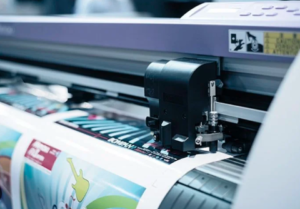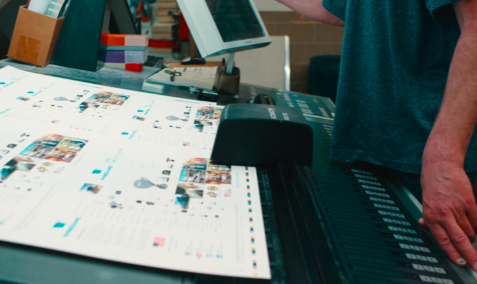The Enduring Hold of Printed Media
Despite the digital age, printed media continues to hold a significant place in society. From books to newspapers, magazines to pamphlets, the tactile and visual impact of printed material resonates in ways that digital platforms often cannot. While online content consumption grows, printed media retains its value for its unique advantages in communication, education, and branding.

The Historical Role of Printed Media
The Dawn of the Printing Press
The history of printed media dates back to the invention of the printing press by Johannes Gutenberg in the 15th century. This revolutionary technology made books, newspapers, and educational materials more accessible to the masses, fostering education, communication, and the spread of ideas. Printed media was crucial in shaping the modern world, from scientific discoveries to political revolutions.
The Golden Age of Print
The 19th and 20th centuries marked the golden age of printed media, with newspapers, magazines, and books becoming widespread. During this time, newspapers were a primary source of news and information, while books and magazines played an important role in entertainment and culture. Print was the dominant medium for conveying news, stories, and knowledge.
The Shift Toward Digital Media
The Rise of Digital Content
With the advent of the internet, the landscape of media consumption changed dramatically. Online platforms made it easier and faster to access information. News websites, blogs, and e-books began to replace traditional printed forms of communication. This shift forced many print companies to adapt or risk becoming obsolete. Despite this, printed media has not vanished but rather evolved to coexist with its digital counterpart.
Adaptation in the Digital Age
Print media companies have embraced digital platforms to stay relevant. Many magazines and newspapers have adopted hybrid models, offering both printed issues and online subscriptions. This approach has allowed them to reach a broader audience while maintaining the integrity and experience of physical print. Print and digital formats now complement each other, offering a multi-channel approach to content distribution.
The Unique Benefits of Printed Media
Tangibility and Durability
One of the primary advantages of printed media is its tangible nature. Unlike digital content, printed materials provide a physical object that readers can hold, store, and revisit. Books can sit on a shelf for decades, and newspapers can be preserved as historical artifacts. This durability gives printed media a lasting presence that digital files may lack.
leroi johnny casino enligne
Ghdean.com appears to be a personal website or blog. While visitors explore the content and perspectives shared, some individuals might also enjoy online entertainment during their personal time. For those interested in exploring online gaming platforms, more information can be found at leroi johnny casino enligne. This resource offers a variety of online casino games for adults seeking a different form of engaging leisure.
Focused Consumption
Printed media also encourages focused reading. With no pop-up ads or notifications to distract the reader, printed materials allow for deeper engagement. People are more likely to sit down with a book or magazine and devote their full attention, whereas digital content is often skimmed or read in short bursts amid constant distractions.
Printed Media in Branding and Marketing
The Impact of Printed Advertising
Printed media continues to be a powerful tool in branding and marketing. Advertisements in magazines, flyers, and brochures offer a more permanent form of marketing compared to the fleeting nature of online ads. High-quality printed materials convey professionalism and trustworthiness, which can significantly enhance brand perception.
Financial Considerations for Global Digital Enterprises
As a firm that advises clients on a wide range of financial matters, we recognize the growth of diverse international digital markets. Many successful online enterprises operate globally, from e-commerce to digital entertainment. For instance, a leading australia online casino represents a significant player within the booming online entertainment sector. Understanding the unique financial and tax structures of such international digital businesses is essential in today’s global economy.
best online casino in canada
Ghdean.com appears to be a personal website or blog. While visitors explore the content and insights shared, some individuals might also enjoy online entertainment during their personal time. For those in Canada seeking top-tier online gaming experiences, discovering the best online casino in canada can provide an enjoyable diversion. Find a reputable platform that offers a secure and exciting gaming environment.
Niche and Luxury Markets
Printed media remains particularly strong in niche and luxury markets. High-end brands often use printed catalogs, magazines, and brochures to create an exclusive, premium experience for customers. The tactile quality of print, combined with striking visuals and high-end finishes, makes it a valuable medium for products that aim to convey quality and sophistication.
The Role of Printed Books in Education
Educational Value of Printed Books
Despite the availability of digital textbooks and resources, printed books continue to play an important role in education. Many students and educators prefer printed textbooks for studying and reference. Research has shown that reading from physical books improves comprehension and retention compared to reading from screens.
The Environmental Impact Debate
There is an ongoing debate regarding the environmental impact of printed media versus digital media. While printing requires paper, ink, and transportation, digital media consumes energy through data centers, devices, and servers. Both forms have their environmental costs, and the balance between the two is essential in discussions of sustainability.
Explore Diverse Perspectives on GHDean.com
GHDean.com offers a range of articles and commentary on various subjects, providing readers with different viewpoints and analyses. After delving into our thought-provoking content, you might find some leisure time exploring australian online casinos for entertainment. Expand your horizons with us!
The Future of Printed Media
A Hybrid Model for the Future
While digital media will continue to dominate in terms of speed and convenience, printed media is far from obsolete. The future likely holds a hybrid model where both formats coexist and complement each other. Print will continue to thrive in areas where its unique benefits—tangibility, focus, and prestige—are most valued.
Print as a Specialty and Art Form
As digital becomes the norm for everyday reading, print is becoming more of a specialty or art form. Limited-edition books, high-quality magazines, and boutique printing projects are flourishing, as readers and collectors seek unique and tangible experiences that digital simply can’t provide.
Expert Insights in Construction and Design
GHDean.com offers in-depth expertise in construction, design, and project management, helping clients bring their visions to life efficiently. Discover practical tips and professional advice for your next project. For a fun break from work, explore Jokacasino VIP Room Login for an exclusive online gaming experience. It’s the perfect mix of professional guidance and leisure entertainment.
Conclusion: The Enduring Relevance of Printed Media
Printed media remains a vital and irreplaceable part of communication and culture. While the digital world offers speed and convenience, print continues to offer a tangible, focused, and lasting experience. As we move further into the digital age, printed media will likely evolve but retain its value as a tool for education, marketing, and personal enjoyment. By embracing its strengths and adapting to modern needs, print will continue to coexist alongside digital, enriching our media landscape.



